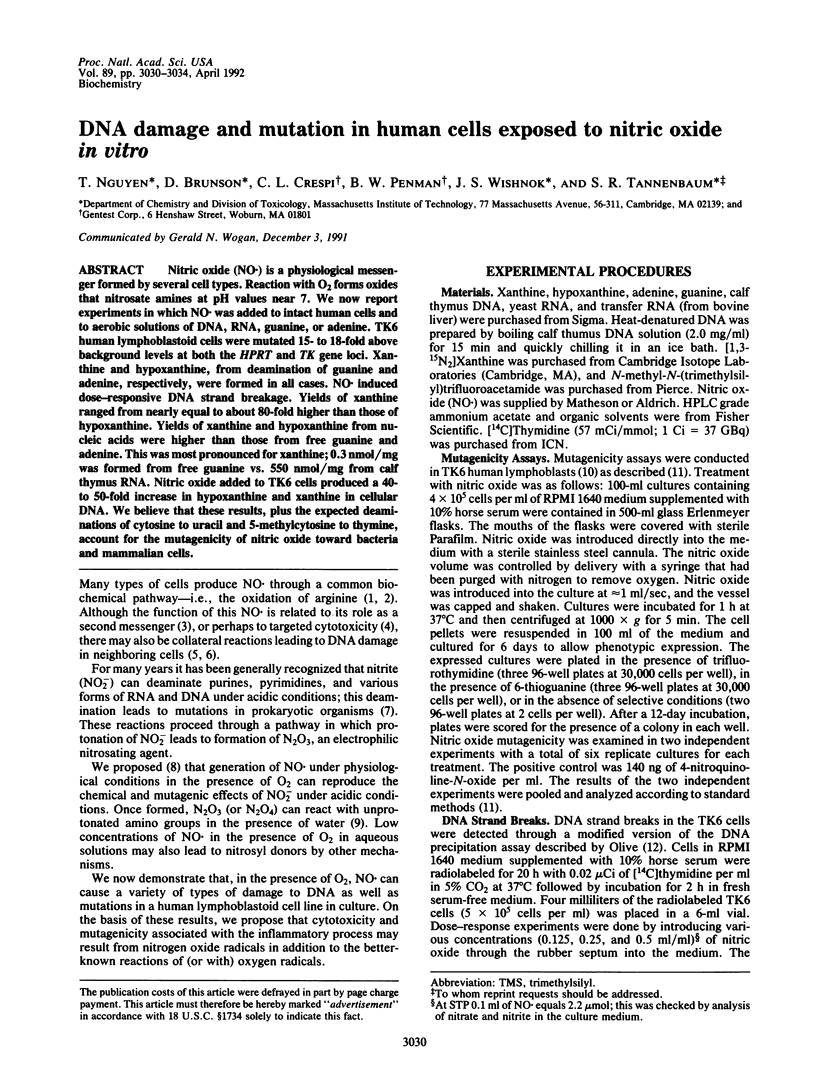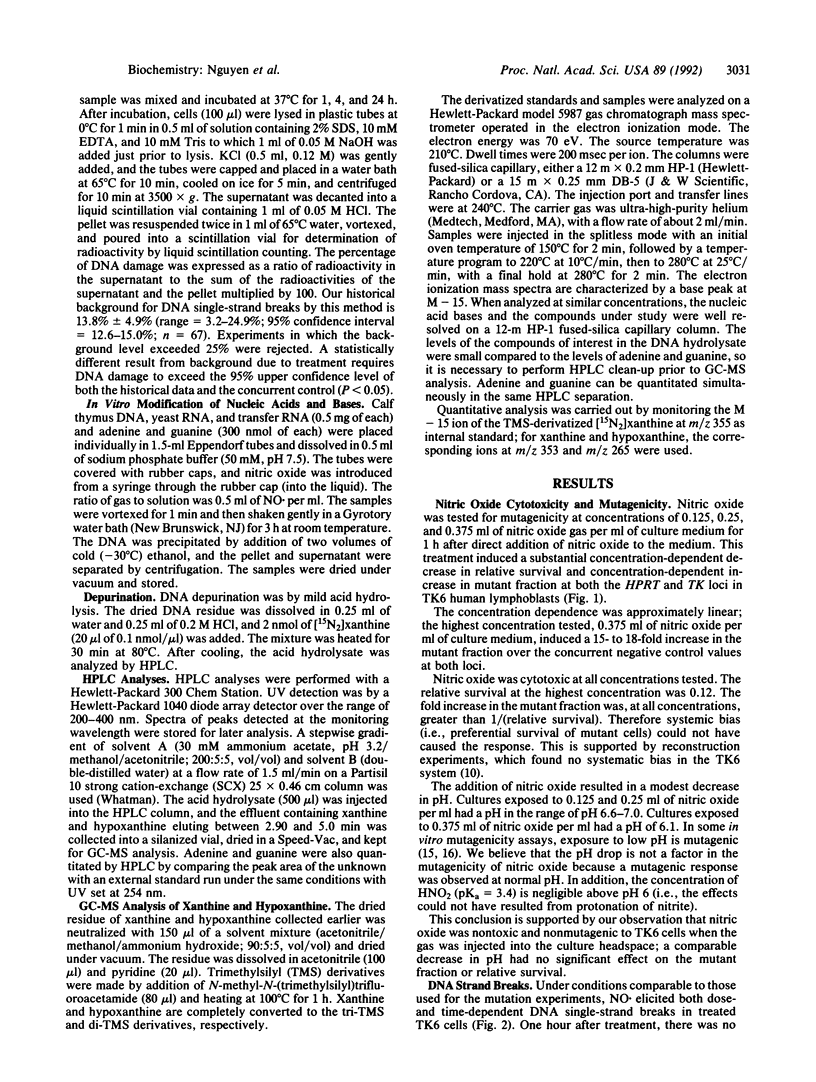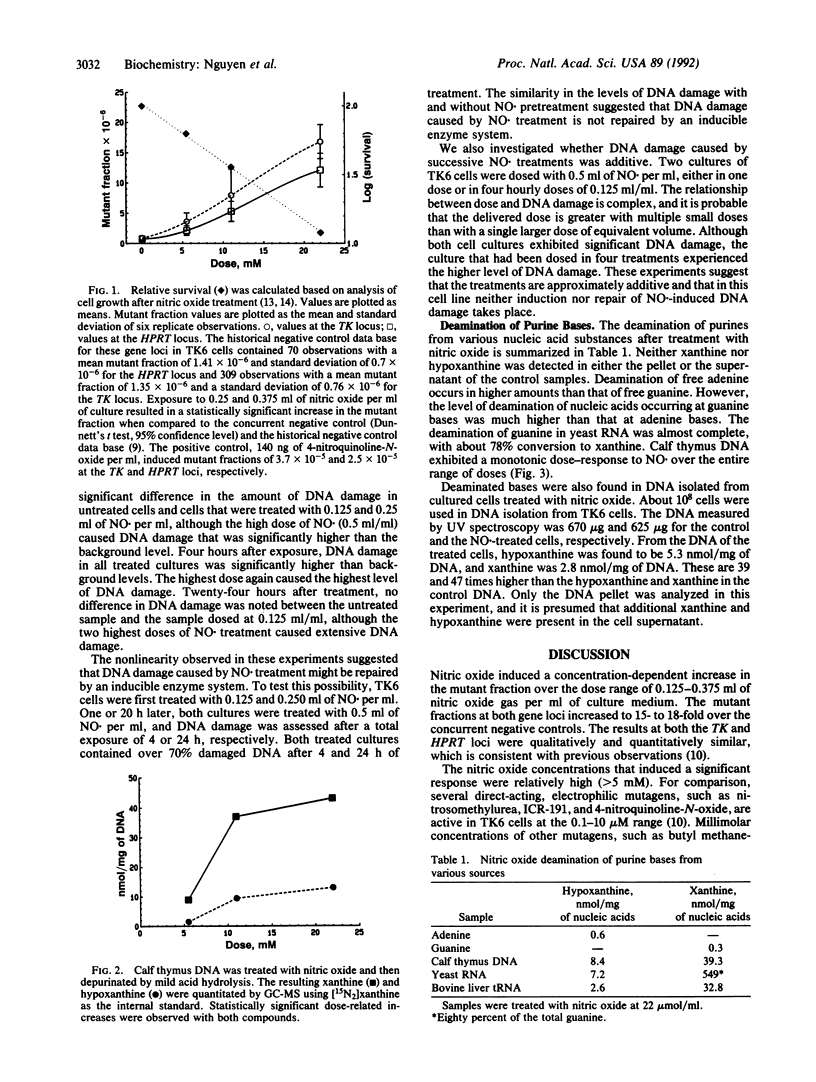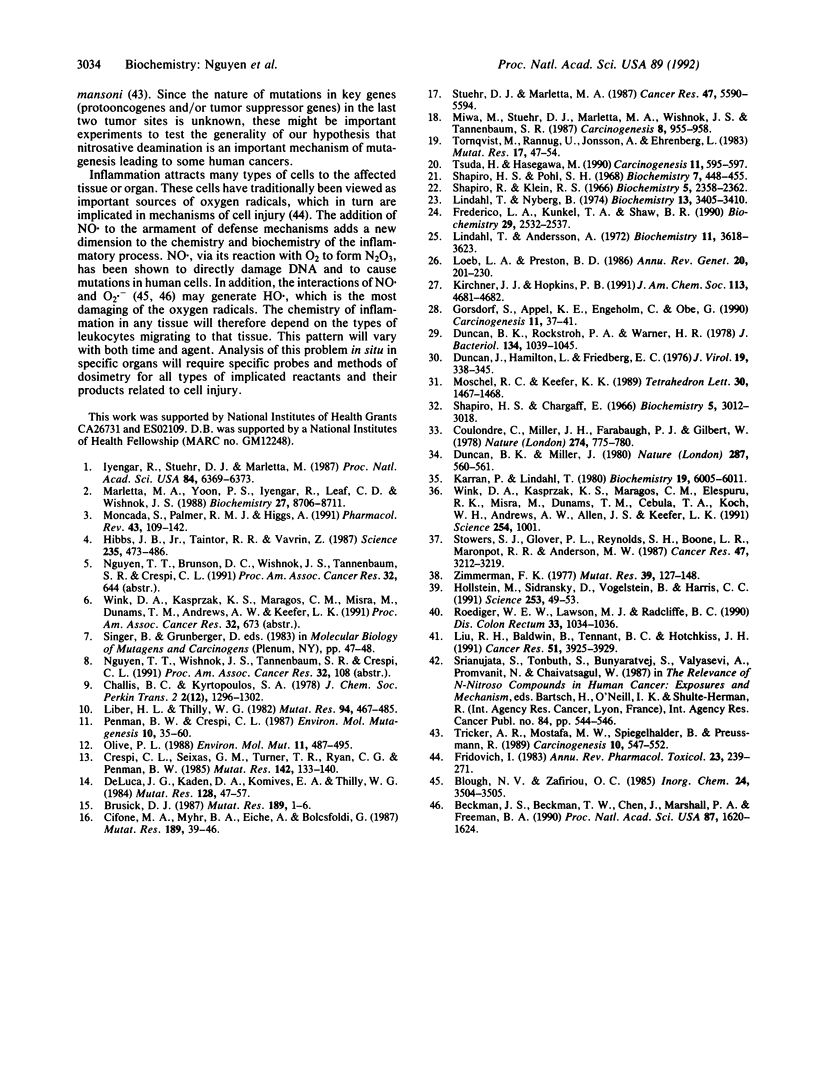Abstract
Nitric oxide (NO.) is a physiological messenger formed by several cell types. Reaction with O2 forms oxides that nitrosate amines at pH values near 7. We now report experiments in which NO. was added to intact human cells and to aerobic solutions of DNA, RNA, guanine, or adenine. TK6 human lymphoblastoid cells were mutated 15- to 18-fold above background levels at both the HPRT and TK gene loci. Xanthine and hypoxanthine, from deamination of guanine and adenine, respectively, were formed in all cases. NO. induced dose-responsive DNA strand breakage. Yields of xanthine ranged from nearly equal to about 80-fold higher than those of hypoxanthine. Yields of xanthine and hypoxanthine from nucleic acids were higher than those from free guanine and adenine. This was most pronounced for xanthine; 0.3 nmol/mg was formed from free guanine vs. 550 nmol/mg from calf thymus RNA. Nitric oxide added to TK6 cells produced a 40- to 50-fold increase in hypoxanthine and xanthine in cellular DNA. We believe that these results, plus the expected deaminations of cytosine to uracil and 5-methylcytosine to thymine, account for the mutagenicity of nitric oxide toward bacteria and mammalian cells.
Full text
PDF




Images in this article
Selected References
These references are in PubMed. This may not be the complete list of references from this article.
- Beckman J. S., Beckman T. W., Chen J., Marshall P. A., Freeman B. A. Apparent hydroxyl radical production by peroxynitrite: implications for endothelial injury from nitric oxide and superoxide. Proc Natl Acad Sci U S A. 1990 Feb;87(4):1620–1624. doi: 10.1073/pnas.87.4.1620. [DOI] [PMC free article] [PubMed] [Google Scholar]
- Brusick D. J. Implications of treatment-condition-induced genotoxicity for chemical screening and data interpretation. Mutat Res. 1987 Sep;189(1):1–6. doi: 10.1016/0165-1218(87)90026-7. [DOI] [PubMed] [Google Scholar]
- Cifone M. A., Myhr B., Eiche A., Bolcsfoldi G. Effect of pH shifts on the mutant frequency at the thymidine kinase locus in mouse lymphoma L5178Y TK+/- cells. Mutat Res. 1987 Sep;189(1):39–46. doi: 10.1016/0165-1218(87)90031-0. [DOI] [PubMed] [Google Scholar]
- Coulondre C., Miller J. H., Farabaugh P. J., Gilbert W. Molecular basis of base substitution hotspots in Escherichia coli. Nature. 1978 Aug 24;274(5673):775–780. doi: 10.1038/274775a0. [DOI] [PubMed] [Google Scholar]
- Crespi C. L., Seixas G. M., Turner T. R., Ryan C. G., Penman B. W. Mutagenicity of 1,2-dichloroethane and 1,2-dibromoethane in two human lymphoblastoid cell lines. Mutat Res. 1985 Mar;142(3):133–140. doi: 10.1016/0165-7992(85)90053-3. [DOI] [PubMed] [Google Scholar]
- DeLuca J. G., Kaden D. A., Komives E. A., Thilly W. G. Mutation of xeroderma pigmentosum lymphoblasts by far-ultraviolet light. Mutat Res. 1984 Aug;128(1):47–57. doi: 10.1016/0027-5107(84)90046-0. [DOI] [PubMed] [Google Scholar]
- Duncan B. K., Miller J. H. Mutagenic deamination of cytosine residues in DNA. Nature. 1980 Oct 9;287(5782):560–561. doi: 10.1038/287560a0. [DOI] [PubMed] [Google Scholar]
- Duncan B. K., Rockstroh P. A., Warner H. R. Escherichia coli K-12 mutants deficient in uracil-DNA glycosylase. J Bacteriol. 1978 Jun;134(3):1039–1045. doi: 10.1128/jb.134.3.1039-1045.1978. [DOI] [PMC free article] [PubMed] [Google Scholar]
- Duncan J., Hamilton L., Friedberg E. C. Enzymatic degradation of uracil-containing DNA. II. Evidence for N-glycosidase and nuclease activities in unfractionated extracts of Bacillus subtilis. J Virol. 1976 Aug;19(2):338–345. doi: 10.1128/jvi.19.2.338-345.1976. [DOI] [PMC free article] [PubMed] [Google Scholar]
- Frederico L. A., Kunkel T. A., Shaw B. R. A sensitive genetic assay for the detection of cytosine deamination: determination of rate constants and the activation energy. Biochemistry. 1990 Mar 13;29(10):2532–2537. doi: 10.1021/bi00462a015. [DOI] [PubMed] [Google Scholar]
- Fridovich I. Superoxide radical: an endogenous toxicant. Annu Rev Pharmacol Toxicol. 1983;23:239–257. doi: 10.1146/annurev.pa.23.040183.001323. [DOI] [PubMed] [Google Scholar]
- Görsdorf S., Appel K. E., Engeholm C., Obe G. Nitrogen dioxide induces DNA single-strand breaks in cultured Chinese hamster cells. Carcinogenesis. 1990 Jan;11(1):37–41. doi: 10.1093/carcin/11.1.37. [DOI] [PubMed] [Google Scholar]
- Hibbs J. B., Jr, Taintor R. R., Vavrin Z. Macrophage cytotoxicity: role for L-arginine deiminase and imino nitrogen oxidation to nitrite. Science. 1987 Jan 23;235(4787):473–476. doi: 10.1126/science.2432665. [DOI] [PubMed] [Google Scholar]
- Hollstein M., Sidransky D., Vogelstein B., Harris C. C. p53 mutations in human cancers. Science. 1991 Jul 5;253(5015):49–53. doi: 10.1126/science.1905840. [DOI] [PubMed] [Google Scholar]
- Iyengar R., Stuehr D. J., Marletta M. A. Macrophage synthesis of nitrite, nitrate, and N-nitrosamines: precursors and role of the respiratory burst. Proc Natl Acad Sci U S A. 1987 Sep;84(18):6369–6373. doi: 10.1073/pnas.84.18.6369. [DOI] [PMC free article] [PubMed] [Google Scholar]
- Karran P., Lindahl T. Hypoxanthine in deoxyribonucleic acid: generation by heat-induced hydrolysis of adenine residues and release in free form by a deoxyribonucleic acid glycosylase from calf thymus. Biochemistry. 1980 Dec 23;19(26):6005–6011. doi: 10.1021/bi00567a010. [DOI] [PubMed] [Google Scholar]
- Liber H. L., Thilly W. G. Mutation assay at the thymidine kinase locus in diploid human lymphoblasts. Mutat Res. 1982 Jun;94(2):467–485. doi: 10.1016/0027-5107(82)90308-6. [DOI] [PubMed] [Google Scholar]
- Lindahl T., Andersson A. Rate of chain breakage at apurinic sites in double-stranded deoxyribonucleic acid. Biochemistry. 1972 Sep 12;11(19):3618–3623. doi: 10.1021/bi00769a019. [DOI] [PubMed] [Google Scholar]
- Lindahl T., Nyberg B. Heat-induced deamination of cytosine residues in deoxyribonucleic acid. Biochemistry. 1974 Jul 30;13(16):3405–3410. doi: 10.1021/bi00713a035. [DOI] [PubMed] [Google Scholar]
- Liu R. H., Baldwin B., Tennant B. C., Hotchkiss J. H. Elevated formation of nitrate and N-nitrosodimethylamine in woodchucks (Marmota monax) associated with chronic woodchuck hepatitis virus infection. Cancer Res. 1991 Aug 1;51(15):3925–3929. [PubMed] [Google Scholar]
- Loeb L. A., Preston B. D. Mutagenesis by apurinic/apyrimidinic sites. Annu Rev Genet. 1986;20:201–230. doi: 10.1146/annurev.ge.20.120186.001221. [DOI] [PubMed] [Google Scholar]
- Marletta M. A., Yoon P. S., Iyengar R., Leaf C. D., Wishnok J. S. Macrophage oxidation of L-arginine to nitrite and nitrate: nitric oxide is an intermediate. Biochemistry. 1988 Nov 29;27(24):8706–8711. doi: 10.1021/bi00424a003. [DOI] [PubMed] [Google Scholar]
- Miwa M., Stuehr D. J., Marletta M. A., Wishnok J. S., Tannenbaum S. R. Nitrosation of amines by stimulated macrophages. Carcinogenesis. 1987 Jul;8(7):955–958. doi: 10.1093/carcin/8.7.955. [DOI] [PubMed] [Google Scholar]
- Moncada S., Palmer R. M., Higgs E. A. Nitric oxide: physiology, pathophysiology, and pharmacology. Pharmacol Rev. 1991 Jun;43(2):109–142. [PubMed] [Google Scholar]
- Olive P. L. DNA precipitation assay: a rapid and simple method for detecting DNA damage in mammalian cells. Environ Mol Mutagen. 1988;11(4):487–495. doi: 10.1002/em.2850110409. [DOI] [PubMed] [Google Scholar]
- Penman B. W., Crespi C. L. Analysis of human lymphoblast mutation assays by using historical negative control data bases. Environ Mol Mutagen. 1987;10(1):35–60. doi: 10.1002/em.2850100106. [DOI] [PubMed] [Google Scholar]
- Roediger W. E., Lawson M. J., Radcliffe B. C. Nitrite from inflammatory cells--a cancer risk factor in ulcerative colitis? Dis Colon Rectum. 1990 Dec;33(12):1034–1036. doi: 10.1007/BF02139219. [DOI] [PubMed] [Google Scholar]
- Shapiro H. S., Chargaff E. Studies on the nucleotide arrangement in deoxyribonucleic acids. XI. Selective removal of cytosine as a tool for the study of the nucleotide arrangement in deoxyribonucleic acid. Biochemistry. 1966 Sep;5(9):3012–3018. doi: 10.1021/bi00873a034. [DOI] [PubMed] [Google Scholar]
- Shapiro R., Klein R. S. The deamination of cytidine and cytosine by acidic buffer solutions. Mutagenic implications. Biochemistry. 1966 Jul;5(7):2358–2362. doi: 10.1021/bi00871a026. [DOI] [PubMed] [Google Scholar]
- Shapiro R., Pohl S. H. The reaction of ribonucleosides with nitrous acid. Side products and kinetics. Biochemistry. 1968 Jan;7(1):448–455. doi: 10.1021/bi00841a057. [DOI] [PubMed] [Google Scholar]
- Stowers S. J., Glover P. L., Reynolds S. H., Boone L. R., Maronpot R. R., Anderson M. W. Activation of the K-ras protooncogene in lung tumors from rats and mice chronically exposed to tetranitromethane. Cancer Res. 1987 Jun 15;47(12):3212–3219. [PubMed] [Google Scholar]
- Stuehr D. J., Marletta M. A. Synthesis of nitrite and nitrate in murine macrophage cell lines. Cancer Res. 1987 Nov 1;47(21):5590–5594. [PubMed] [Google Scholar]
- Tricker A. R., Mostafa M. H., Spiegelhalder B., Preussmann R. Urinary excretion of nitrate, nitrite and N-nitroso compounds in Schistosomiasis and bilharzia bladder cancer patients. Carcinogenesis. 1989 Mar;10(3):547–552. doi: 10.1093/carcin/10.3.547. [DOI] [PubMed] [Google Scholar]
- Tsuda H., Hasegawa M. Malignant transformation of mouse BALB/c3T3 cells induced by NaNO2. Carcinogenesis. 1990 Apr;11(4):595–597. doi: 10.1093/carcin/11.4.595. [DOI] [PubMed] [Google Scholar]
- Törnqvist M., Rannug U., Jonsson A., Ehrenberg L. Mutagenicity of methyl nitrite in Salmonella typhimurium. Mutat Res. 1983 Apr;117(1-2):47–54. doi: 10.1016/0165-1218(83)90152-0. [DOI] [PubMed] [Google Scholar]
- Wink D. A., Kasprzak K. S., Maragos C. M., Elespuru R. K., Misra M., Dunams T. M., Cebula T. A., Koch W. H., Andrews A. W., Allen J. S. DNA deaminating ability and genotoxicity of nitric oxide and its progenitors. Science. 1991 Nov 15;254(5034):1001–1003. doi: 10.1126/science.1948068. [DOI] [PubMed] [Google Scholar]
- Zimmermann F. Genetic effects of nitrous acid. Mutat Res. 1977;39(2):127–148. doi: 10.1016/0165-1110(77)90019-7. [DOI] [PubMed] [Google Scholar]



